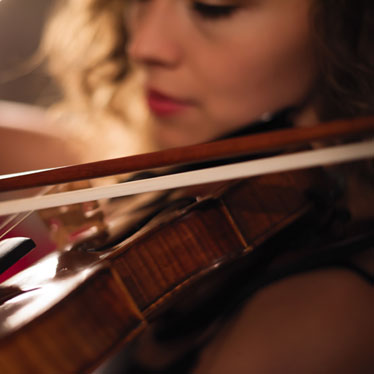
Practice is essential for musical proficiency. However, not all practice makes perfect. In fact, an uninspiring setting, the wrong time of day or an over-achieving practice itinerary can hurt - rather than help - your musical development.
Like all string players, violists have their own set of "dos and don'ts" that should govern their practice time. Here are some of the viola practice "dos and don'ts" that will enhance your overall playing and performance experience.
DO: Create a practice space that is inviting and allows you to focus
While you don't have to have a dedicated practice room, you do need to create a practice space that's conducive to the task at hand. This requires:
- All of your musical equipment, including sheet music, within reach
- A music stand
- Adequate lighting
- Limited to no distractions
Read, Creating the Practice Space, for further suggestions on how to manipulate your environment in a way that supports your musical endeavors.
Just as you should set big-picture goals for your music progress, it's also a good idea to create specific goals for each practice session so you have a clear sense of where you're headed and what's needed to get there.
DON'T: Practice when you're hungry, overly tired or in a rush
When you get right down to it, your body is the foundation of your practice space. If it's overly-tired, hungry, irritable or in a rush - it won't be able to practice in a way that benefits your musicianship.
While we don't advocate skipping practice on a regular basis, an overly tired musician may benefit from a good nap, rather than practice, so the next day's practice time is more efficient. Or, you may find that a quick cat-nap allows you to practice a little later than planned, with much better results. Similarly, eating a nutritious snack ahead of time will give your body and brain the fuel it needs to concentrate and remain engaged with your music.
DO: Divide practice time (or sessions) into separate objectives
Ultimately, there are three different types of practice:
- Practicing for technique
- Practicing to learn new material
- Practicing for optimizing a performance
If you practice without clear objectives in mind, your mind, fingers and attention will be all over the map. If you set clear objectives each time, in regards to what you're focusing on, the outcome will be more dramatic and practice sessions will remain more interesting.
DON'T: Use a boiler plate practice schedule
One of the main reasons viola players moan and groan about practice time is that "it's boring..." While you may not love doing scales and arpeggios on a daily basis, consider that your boiler plate approach to practices may be the real issue, rather than practice time in general.
If your practice time feels like Groundhog Day, it's time to shake things up a bit. First, remember the varied objectives discussed above and create small portions - or entire practice times - to each one, depending on where you're at in the calendar and performance schedule. Make room for improvisation, use a mirror and watch yourself as you play to develop body awareness and muscle memory around technique, allow time for ear training exercises, take some time to play a piece of music you know and love and play around with different expressive techniques so it never sounds the same way twice. All of these can be rotated in and out of your practice time.
Think of practice time as a more structured version of a "Choose Your Own Adventure..." book, where core themes remain the same but there are variations in the storytelling.
DO: Remain diligent about warm-ups
While finger warm-ups and exercises may feel repetitive, they are essential to the health of your fingers and wrist. This is especially true when you haven't played in a while (like Monday afternoon when you haven't played since Friday). In addition to building muscle memory and more fluid movement along the neck of your viola, warm-ups, scales, and arpeggios increase finger flexibility and minimize the risk of injury or strain.
DON'T: Ignore posture or form during warm-ups
Warm-up time provides the perfect opportunity to concentrate on your physical form and posture. The way you practice is the way you perform, so building correct physical form and technique into your warm-ups and early practice time is a good way to keep the body "in-line" literally, and figuratively, as you move on to other practice areas.
DO: Support your musicianship with healthy lifestyle choices
The healthier you are as a whole, the more successful you'll be as a musician. Make healthy lifestyle choices outside the practice room, in order to support your work there. This includes eating a healthy diet, exercising regularly, practicing stress-reduction techniques and avoiding tobacco, drugs or alcohol. The healthiest musicians enjoy the longest, most successful careers.


